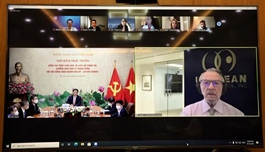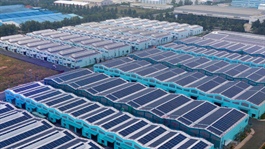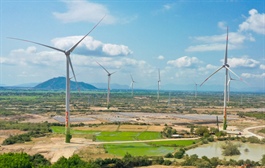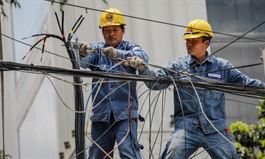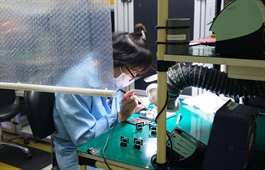Vietnam has fossil energy reduction roadmap: PM
Vietnam has fossil energy reduction roadmap: PM
Vietnam said it will develop no new coal-fired power projects in its national power development plan by 2030.
A roadmap on reducing fossil fuels in Vietnam will be actively conducted in the country’s power generation mix with a vision to 2045, Prime Minister Pham Minh Chinh said at the Russian Energy Week International Forum held on Oct 13-15.

Vietnam's Prime Minister Pham Minh Chinh. Photo: VGP |
No new coal-fired power projects would be developed in the time to come with a focus on reducing CO2 emissions, Chinh said in a pre-recorded speech broadcast at the forum that marked the participation of more than 1,000 delegates.
In the National Power Development Plan VIII (PDP8) for 2021-2030 and vision to 2045, Vietnam will diversify energy sources by increasing the ratio of renewable energy to the power mix to 20% by 2030 and 30% by 2045; accelerating the gas-fueled power to 22% by 2030 from 10% in 2020 while at the same time improving energy efficiency to save around 5-7% of the total energy consumption by 2025, Chinh said.
He noted that being one of the countries with the fastest economic growth in ASEAN, Vietnam is aware of the importance of the energy transition, a pathway toward the transformation of the fossil-based energy sector to renewable energy and energy efficiency measures.
To contribute to implementing the Paris Agreement on climate change, Vietnam has issued a national program on energy efficiency for the 2019-2030 period, Chinh emphasized at the forum specialized in discussing challenges and prospects for the development of the global energy sector.
Vietnam-Russia energy cooperation
Delivering the speech at the event with a plenary discussion attended by Russian President Vladimir Putin, Chinh appreciated the traditional relations with Russia in which energy is one of the key pillars in the comprehensive strategic partnership over the past decades.
He said the presence of many big energy projects in Vietnam, including the Hoa Binh Hydropower Plant and the Uong Bi Thermal Power Plant, has proved the long-lasting relationship between Vietnam and Russia and served as the premises to open an era of cooperation in clean energy.
He affirmed that Vietnam would continue completing the legal framework, including the public-private partnership (PPP), to facilitate the investment of foreign investors, including Russians.
For the past years, investment in oil and gas exploration and exploitation of joint ventures between the two countries has been intensified.
Rosneft in May 2018 started drilling at the LD-3P well, part of the Lan Do “Red Orchid” offshore gas field in Block 06.1, which is 370 km southeast off the coast of Vietnam, according to Reuters.
In May 2019, Rosneft started the drilling operation offshore Vietnam’s southern city of Vung Tau which uses its semi-submersible drilling rig HAKURYU-5 for the drilling operation.
According to data on Rosneft’s website, the Russian oil company is engaged in gas and condensate production projects on 2 offshore Vietnam blocks 06.1 and 05.3/11 and is also a participant of Nam Con Son Pipeline project offshore Vung Tau.
Vietsovpetro, a joint venture set up in 1981 with a 51% stake held by PetroVietnam and 49% by Russia’s wholly state-owned Zarubezhneft, operates in petroleum exploration and production on the southern continental shelf of Vietnam, producing one-third of Vietnam’s oil. The company said it produced an estimated 3.42 million metric tons of crude oil in 2020, down 8.8% on-year.
In a meeting with Vietnam’s Prime Minister Nguyen Xuan Phuc in Moscow in 2019, then Russia’s Prime Minister Dmitry Medvedev said that the two countries would continue running the joint venture for a long time, at least until 2030.
Meanwhile, big Russian oil and gas groups like Gazprom and Rosneft plan to engage in many more projects in Vietnam’s continental shelf by 2030.





